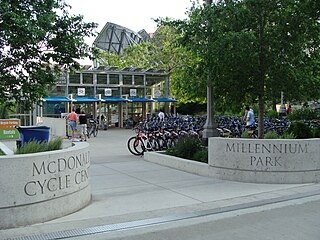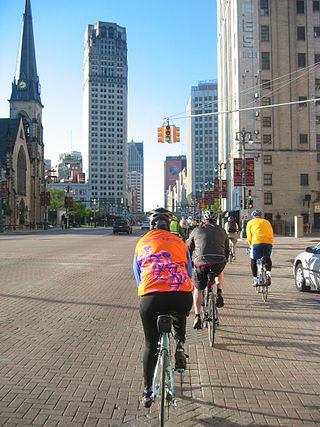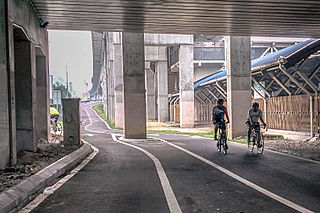
Pace is the suburban bus and regional paratransit division of the Regional Transportation Authority serving the Chicago metropolitan area. It was created in 1983 by the RTA Act, which established the formula that provides funding to the CTA, Metra, and Pace. The various agencies providing bus service in the Chicago suburbs were merged under the Suburban Bus Division, which rebranded as Pace in 1984. In 2022, Pace had 18.041 million riders.

Transportation Alternatives is a non-profit organization in New York City which works to change New York City's transportation priorities to encourage and increase non-polluting, quiet, city-friendly travel and decrease automobile use. TransAlt seeks a transportation system based on a "Green Transportation Hierarchy" giving preference to modes of travel based on their relative benefits and costs to society. To achieve these goals, T.A. works in five areas: Cycling, Walking and Traffic Calming, Car-Free Parks, Safe Streets and Sustainable Transportation. Promotional activities include large group bicycle rides.

Bike the Drive or Fifth Third Bike the Drive is a recreational, non-competitive bicycle ride held each year in Chicago. Lake Shore Drive is cleared of motor vehicle traffic and opened exclusively to bicyclists for several hours beginning at dawn. The event benefits bicycling advocacy work in the region by the Active Transportation Alliance, formerly known as the Chicagoland Bicycle Federation. Since 2004, Bike the Drive has usually been held on the Sunday of Memorial Day weekend, though it was cancelled in 2020, and in 2021 and 2022 was held in early September. In 2006, an estimated 20,000 riders participated in the event. The event is sponsored by Fifth Third Bank and branded as Fifth Third Bike the Drive; it was previously sponsored by MB Financial Bank from 2010 to 2018 and prior to 2010, was sponsored by Bank of America.

Bike to Work Day is an annual event that promotes the bicycle as an option for commuting to work. It is held in the Spring in a variety of locations including the United States, Canada, Europe and Asia.

The San Francisco Bicycle Coalition (SFBC) is a California 501(c)(4) nonprofit public-benefit corporation established to "transform San Francisco's streets and neighborhoods into more livable and safe places by promoting the bicycle for everyday transportation." Founded in 1971, dormant through much of the 1980s, and re-founded in 1990, the SFBC in 2011 has a dues-paying membership of over 12,000 and is considered to be one of the most influential membership-based advocacy organizations in San Francisco.

Bicycle parking is part of the cycling infrastructure of a populated place allowing for the storage of bicycles when they are not being used. Parking facilities for bicycles include racks, lockers, parking stations, and covered areas. Bicycle parking infrastructure, in addition to cyclists' equipment such bicycle locks, offers a degree of security and may prevent bicycle theft. Ad hoc bicycle parking alongside railings, signs, and other street furniture is a common practice and may be recognized through formal legal arrangements.

Cycling in New York City is associated with mixed cycling conditions that include dense urban proximities, relatively flat terrain, congested roadways with stop-and-go traffic, and streets with heavy pedestrian activity. The city's large cycling population includes utility cyclists, such as delivery and messenger services; cycling clubs for recreational cyclists; and increasingly commuters. Cycling is increasingly popular in New York City; in 2018 there were approximately 510,000 daily bike trips, compared with 170,000 daily bike trips in 2005.

McDonald's Cycle Center is an indoor bike station in the northeast corner of Millennium Park in the Loop community area of Chicago, in the U.S. state of Illinois. The city of Chicago built the center at the intersection of East Randolph Street and Columbus Drive, and opened it July 2004. Since June 2006, it has been sponsored by McDonald's and several other partners, including city departments and bicycle advocacy organizations. The bike station, which serves bicycle commuters and utility cyclists, provides lockers, showers, a snack bar with outdoor summer seating, bike repair, bike rental and 300 bicycle parking spaces as of 2004. The Cycle Center is accessible by membership and day pass. It also accommodates runners and inline skaters, and provides space for a Chicago Police Department Bike Patrol Group.

Chicago, Illinois, is the third-largest city in the United States and a world transit hub. The area is served by two major airports, numerous highways, elevated/subway local train lines, and city/suburban commuter rail lines; it is the national passenger rail hub for Amtrak routes, and also the main freight rail hub of North America.

Toronto, Ontario, like many North American cities, has slowly been expanding its purpose-built cycling infrastructure. The number of cyclists in Toronto has been increasing progressively, particularly in the city's downtown core. As cycling conditions improve, a cycling culture has grown and alternatives such as automobiles are seen as less attractive. The politics of providing resources for cyclists, particularly dedicated bike lanes, has been contentious, particularly since the 2010s.

The Chicago Lakefront Trail (LFT) is a 18.5-mile-long (29.8 km) partial shared-use path for walking, jogging, skateboarding, and cycling, located along the western shore of Lake Michigan in Chicago, Illinois. The trail passes through and connects Chicago's four major lakefront parks along with various beaches and recreational amenities. It also serves as a route for bicycle, skateboard and personal transporter commuters. On busy summer days 70,000 people use the trail.
Cycling in Illinois encompasses recreation, bikeways, laws and rules, and advocacy. The director of the Illinois Department of Natural Resources, Joel Brunsvold, explained Illinois cycling opportunities: “Bicycle riding is one of the most popular outdoor recreational activities in Illinois, enjoyed by young and old alike...Illinois has a variety of trails for the public to enjoy. The terrain includes flat prairie land to rolling hills, towering bluffs to the breathtaking river and lakefront views.” Many communities across the state are updating bicycle infrastructure in order to accommodate the increased number of cyclists on the roads.

Detroit is a popular city for cycling. It is flat with an extensive road network with a number of recreational and competitive opportunities and is, according to cycling advocate David Byrne, one of the top eight biking cities in the world. The city has invested in greenways and bike lanes and other bicycle-friendly infrastructure. Bike rental is available from the riverfront and tours of the city's architecture can be booked.

Bicycle use in Portland, Oregon has been growing rapidly, having nearly tripled since 2001; for example, bicycle traffic on four of the Willamette River bridges has increased from 2,855 before 1992 to over 16,000 in 2008, partly due to improved facilities. The Portland Bureau of Transportation says 6% of commuters bike to work in Portland, the highest proportion of any major U.S. city and about 10 times the national average.

Cycling in San Francisco has grown in popularity in recent years, aided by improving cycling infrastructure and community support. San Francisco's compact urban form and mild climate enable cyclists to reach work, shopping, and recreational destinations quickly and comfortably. Though San Francisco's famed steep hills can make cycling difficult, many parts of the city are relatively flat, including some of the most densely populated. However, heavy automobile traffic, the lack of bike lanes on many streets, and difficulty in crossing major streets deter most residents from cycling frequently in San Francisco.
The San Francisco Bicycle Plan is the current guiding document for near-term bicycle transportation improvements in San Francisco, and was adopted unanimously by the Board of Supervisors on August 11, 2009. The overall goal of the plan is to "increase safe bicycle use" over an expected implementation timeline of 5 years. The plan recommends 60 near-term improvements to the bicycle route network, 52 of which are the addition of bicycle lanes to 34 miles of city streets to the already existing 45 miles of city streets with bicycle lanes.

Cycling in Atlanta has grown in popularity in recent years, from 0.33% of commutes in 2000 to 1.1% in 2009, aided by improving cycling infrastructure and community support. Although Atlanta has historically been a city defined by the automobile, its increasingly compact urban form and mild climate are encouraging residents to cycle to work, shopping, and recreational destinations. Though Atlanta's famed hilly topography can make cycling challenging, though fun, many parts of the city are relatively flat, including some of the more densely populated areas. However, heavy automobile traffic, the lack of bike lanes on many streets, and difficulty in crossing major streets deter most residents from cycling frequently in Atlanta.

Divvy is the bicycle sharing system in the Chicago metropolitan area, currently serving the cities of Chicago and Evanston. The system is owned by the Chicago Department of Transportation and has been operated by Lyft since 2019. As of Sept 2021, Divvy operated 16,500 bicycles and over 800 stations, covering 190 square miles.

Cycling in Kuala Lumpur refers to the bicycle uses in Kuala Lumpur, Malaysia for touring, recreational, work and transportation purpose. It was first appeared on 1938 when there is a first road cycling race that has been introduced in Kuala Lumpur. The introduction of the bicycle in Kuala Lumpur was later become one of the preferred transportation methods for students and mid-class citizens. As Kuala Lumpur begin its rapid urbanization progress since 1960s, the usage of bicycle start to decline as people shifting their transportation method to driving. In recent years however, the roads of the city have seen an increased presence of cyclists, whereas the importance of doing exercise has become more recognized. To match this positive change, and to reduce air pollution, the city urgently needs the introduction of more pavements and bicycle lanes, ideally by leveraging on the vast area that is currently taken up by motorways. Given that Kuala Lumpur lacks many bicycle-friendly routes suitable for cyclists in the city, however, proposals of a bicycle infrastructure of urban bicycling program were drafted, mainly under the Kuala Lumpur Structure Plan 2020 and cycling activism by Cycling Kuala Lumpur in order to encourage more citizens of Kuala Lumpur to cycle in the urban area.

San Jose, California has various cycling routes on roads and trails used by both commuters and recreational riders. The city has plans to expand the current 285 miles (459 km) of bike lanes to 400 miles (640 km), and the current 60 miles (97 km) of trails to 100 miles (160 km). San Jose was ranked as a bronze-level bicycle-friendly community by the League of American Bicyclists.






















